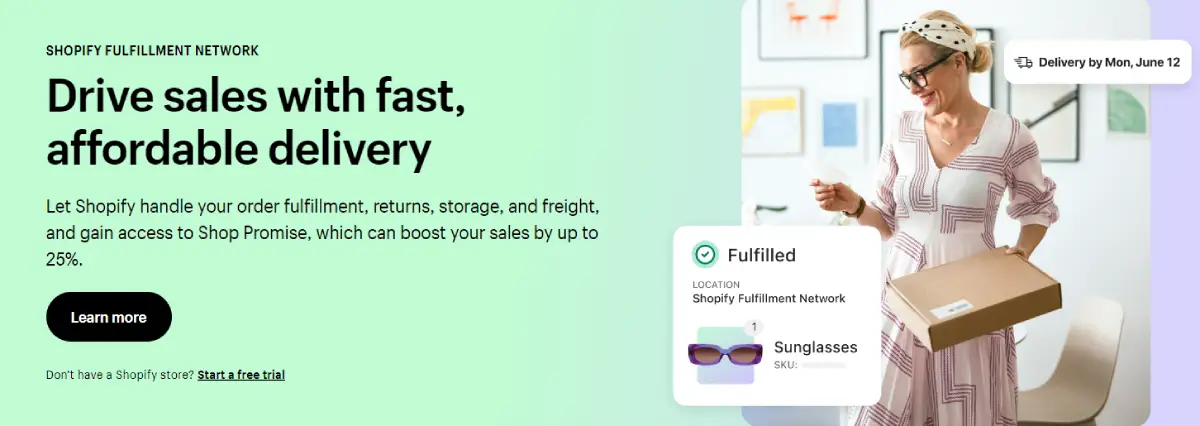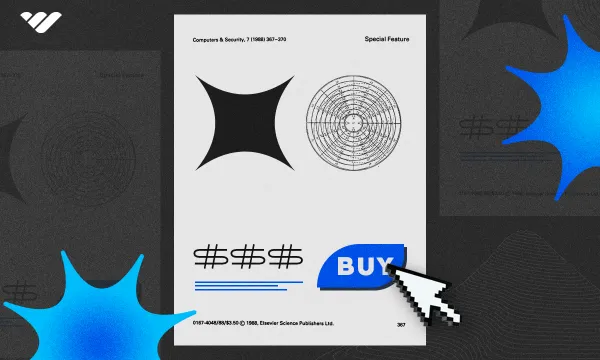Consumers today are more comfortable than ever making purchases online. Gone are the days when they were hesitant to use their credit cards for anything online—it’s as easy as breathing now, a click of a button, a tap of a keyboard, and you get that satisfying notification promising you that your order is on the way.
Behind the curtain, there are a lot of things that need to fall into place in order to make the ecommerce experience smooth and easy. Fulfillment has a lot of working parts, and with some businesses, an entire ecosystem of fulfillment partners working behind the scenes to make sure those orders are carried out promptly.
This article is going to peer behind those curtains and investigate the fulfillment process in ecommerce for digital products, looking at the fundamental ingredients you need so that your business can get fulfillment right!
Jump to:
- What is Ecommerce Fulfillment?
- How Does ecommerce Fulfillment Work?
- Best Strategies for Ecommerce Fulfillment
- Ecommerce Fulfillment Providers for Digital Products
- What to Look For in an Ecommerce Fulfillment Provider
- Challenges in Digital Order Fulfillment
- Whop as Your Ecommerce Fulfillment Partner
What is Ecommerce Fulfillment?
Ecommerce fulfillment generally refers to the process of picking ordered goods off of shelves, packing them, and delivering them to the customer who placed that order. When it comes to digital goods, though, we’re more focused on the processing of the order and payment followed by efficient and secure digital delivery.
Fulfillment with digital goods is therefore a lot simpler than with physical or analog goods - and certainly costs less - but that’s not a reason to pay any less attention to this part of your business. Getting ecommerce fulfillment right can put you above competitors who may make critical errors in this area, and customers who are pleased with your process will be far more loyal.
How Does ecommerce Fulfillment Work?
Ecommerce fulfillment for digital products is different from ecommerce fulfillment for physical goods since you aren’t as concerned with things like inventory, storage, and logistics, but the process shares certain similarities. Let’s look at the different stages involved, in chronological order.
1. Checkout
Whether it’s physical or digital products, the fulfillment process begins when a customer places their order. This is done at checkout, which is a part of the process that you need to make as easy and frictionless as possible—there’s nothing worse than a difficult or buggy checkout process, and the consequences can be severe.
You’re going to be starting off on the wrong foot with your customers if you double-charge them due to a malfunctioning checkout process, and that can end up being costly if things really go wrong. Whether you decide to go it alone or use a third-party solution for your checkout process, it’s worth investing time and money into making it a seamless one.
2. Order and Payment Processing
After your customer places an order at your ecommerce store, all of the details included in it including payment information will have to be verified. Most customers expect this to be a quick process, although certain things might take a little time—especially when it comes to your customer’s chosen payment method being validated and engaged by your payment processing system.
Making this part of the process as fast as possible is a good idea, which is where a good payment processor comes in! Accepting a wide variety of currencies helps too, since ecommerce isn’t constrained by too many borders. At the same time, compliance does need to be maintained.
With all of this in mind, there’s a lot of value to be had when it comes to choosing a solid payment partner. Have you considered Whop for this? Whop takes payments in over 135 currencies, even select cryptocurrencies, and manages compliance while also taking over payment liability since it serves as your Merchant of Record. The icing on the cake is that you can also use Whop to host your ecommerce store, meaning taking over for you right from checkout onwards!
3. Digital Delivery
After the customer’s order has been processed and payment has been confirmed, the onus is back on you to ensure the smoothest possible delivery. This is famously difficult when it comes to physical products, as we’ll touch on later, but it’s easier in digital format.
That said, given just how easy it is to transfer a digital good, you don’t have much room for error. You have to deliver your customer’s digital purchase fast, safely, and in a manner that doesn’t cause any friction or make them jump through any hoops. Email attachments are a great way to deliver digital goods, for instance, but not if the file(s) are above a certain size—email restrictions are a thing, and not every customer will be on an email service that allows very large attachments.
You can also think about digital delivery via a direct download or secure portal, but again, don’t ask your customer to click too many times, or navigate through too many pages.
4. Customer Support
Even though the transaction of digital goods is over by this point, the fulfillment process isn’t quite done. You’ll still need to send your customer order confirmations and invoices via email, and clearly communicate how they can access the digital goods that they purchased as well as what to do or whom to contact if they have any issues.
Ensuring your customers are getting the full use and value out of your product is important too, as is being available in case they have any problems with the product. You or your customer support team need to be able to provide any and all assistance the customer requires, from product-related issues to those revolving around payments.
5. Refunds and Disputes
When you’re running an ecommerce business, returns and refunds are an unfortunate but inescapable part of the journey. No matter how good your products are, there will always be customers who, for whatever reason, want their money back.
The good news here is two-fold. Since the goods we’re talking about here are digital, returns aren’t as problematic as they can be with physical goods, especially items that may be large and unwieldy. This means no expense when it comes to logistics dealing with returns, although digital goods can be troublesome in their own way, such as when a customer downloads the file, saves it, and then tries to get their money back.
The second positive aspect about refunds is that the ball is in your court. It’s possible for you to deal directly with the customer and work out an equitable solution for everyone—you might be able to turn a potential refund into a customer happy enough to evangelize on your behalf.
You might argue that this is far too rose-tinted of a view when looking at refunds, but that’s not true. A customer may choose not to ask you for a refund, and instead initiate a chargeback with their bank instead. This doesn’t give you any chance to deal with them directly, and can be very expensive for you since you’ll be on the hook not just to return the money but also cover all the chargeback fees that crop up.
| Digital Fulfillment | Physical Fulfillment | |
|---|---|---|
| Method | Direct downloads, portal access, email attachments | Picking, packing, and shipment |
| Delivery Time | Usually instant | Depends on proximity to logistics hub, anywhere from same-day to weeks |
| Cost Factors | Servers and bandwidth | Warehousing, picking process, shipping & delivery services |
Best Strategies for Ecommerce Fulfillment
So, now that you know about the different aspects of ecommerce fulfillment for digital goods, it’s time to decide whether you can handle all of it alone or need a partner to take over some or even all of the fulfillment process. Both options can have their benefits and drawbacks -let’s take a closer look.
In-house Fulfillment
Also known as self-fulfillment or DIY fulfillment, this option simply means going it alone and keeping your company in full charge of the ecommerce fulfillment process. This means managing your online storefront and checkout, payment and order processing, digital delivery, customer service, and returns and refunds.
Whether or not you do all of this yourself generally depends on how much control you want over the entire process, and how much of the responsibility (and liability) you’re willing to take. It’s also time-consuming to manage all of this, and if you’re not careful you could find yourself swamped by a deluge of data entry and customer inquiries.
That said, the fact that you maintain a direct link to the customer and have so much control can be an advantage. Any interaction with a customer is a chance to build a positive rapport, and so outsourcing that can be a risk if your provider’s customer service falls short of the mark.
With this option, your ultimate goal of scaling your business can actually become a threat as you start realizing it. The more you sell, the more orders and payments you have to process, the more customer service interactions you’ll have—you may find yourself having to invest more and more into staff and infrastructure to keep a handle on all of these demands.
Find the Right Partners
In-house fulfillment isn’t for everyone, since as we detailed above, it can be a significant burden on both the time and resources of entrepreneurs who prefer to devote maximum attention to their product.
For this reason, finding partners to take over various aspects of the fulfillment process is an excellent idea. Just how much of the process you’d like to hand over is up to you—some business owners can’t bear the thought of giving up control, so they might only sign up with a payment processor and do the rest themselves.
Others may look for a single partner who can help with the entire fulfillment process. It helps to not mix and match too many types of software and can make communication a lot easier since you’re dealing with a single provider and not several of them.
In that sense, you should definitely consider a partner like Whop. As a Merchant of Record (MoR), Whop can take over all of your payment processing - including the liabilities for payment - and can also handle your online store via its marketplace platform. This means digital delivery is taken care of too.
Best of all, Whop can also take over the duties of customer support and ensure that the bulk of queries are taken care of quickly. With an average response time of just three minutes and a 97% satisfaction rating, your customers are in very good hands with Whop!
Ecommerce Fulfillment Providers for Digital Products
If you're choosing to partner with an ecommerce fulfillment provider then Whop has you covered. We've explored the top fulfillment providers of digital products and outlined their offerings and advantages.
1. Whop

When it comes to ecommerce fulfillment for digital products, it’s very hard to look past Whop as your one-stop shop solutions provider and fulfillment partner. Whop’s MoR services allow you to go about your business without worrying about any aspect of the payments process, and your customers will love you for the fact that Whop can facilitate payments in over 135 national currencies as well as select cryptocurrencies.
We’ve already mentioned what Whop can do from a customer service and support point of view, so you’re taken care of at the latter stages of the fulfillment process too. Beyond that, Whop’s online storefront is extremely easy to set up and customize, and not only are you providing your customers with a great online shopping experience, you’re also going to reap the benefits of being listed on Whop’s marketplace.
Whop has a proven track record of successful fulfillment in digital goods, so pay the site a visit and give Whop a try!
💲Pricing: No monthly fee! Whop charges an industry-leading 3% flat fee from sales, plus Stripe or PayPal fees. If you want Whop to act as your MoR, then the fees are 4.5% + 40cents.
2. Shopify/Shopify Fulfillment Network

Shopify is one of the biggest names in ecommerce, and it has an extremely powerful fulfillment service for businesses like yours. The focus is primarily on physical goods, but it’s easy to sign up if you already have a Shopify store offering digital goods.
Quite simply, Shopify takes over the fulfillment service all the way from checkout via your Shopify store to inventory, packing, and shipping. They also handle returns and customer service, and you can consider this option as an alternative to FBA.
The main advantage offered by Shopify is same-day order packing and shipping, meaning that your customers will receive their goods as soon as possible. In fact, Shopify advertises a 98% on-time rate, with deliveries promised in three days or less. While these stats are not relevant to digital goods, they could be useful if you decide to introduce physical goods to your business.
So, if you’re considering adding physical goods to your shelves at some point down the line, you can get selling on Shopify and offer digital downloads while you get your physical inventory ready to go!
💲Pricing: Introductory plan of $1 per month before you choose the tier that suits you best: Basic costs $39 per/mo, while the top end Advanced plan will run you §399 per month.
3. Gumroad

Gumroad is a simple but versatile ecommerce platform that allows you to sell any kind of digital products or services. The options offered by Gumroad go all the way through your merchant journey—you can set up a storefront with Gumroad if you don’t already have a website, or link your site if you do. Then it’s just a matter of uploading a file and setting a price.
One of the advantages of Gumroad is that it’s very in-tune with the needs of the modern entrepreneur, and you can just as easily use it whether you’re a content creator, the next big thing in SaaS, or an eBook author. Subscriptions are extremely easy to set up on Gumroad, and they grant all of the functionality you need for digital fulfillment, from multiple versions and formats, to license key generation, and even lightweight DRM.
💲Pricing: No monthly fee. Gumroad charges a 10% flat fee from sales, plus credit card processing and PayPal fees
📚 Read: Why Whop Marketplace is the best Gumroad alternative
4. BigCommerce

BigCommerce offers a very different vibe to platforms like Gumroad, and that’s intentional—they’re a serious platform for digital commerce with a strong focus on flexibility.
An award-winning ecommerce solution provider, BigCommerce offers an open SaaS platform with API integrations to build and sell however you want. You can create an extremely robust commerce experience in as differentiated manner as possible, with fantastic options for storefront design and conversion.
BigCommerce is an international solutions provider too, with over 100+ currencies accepted and local payments through whichever gateway you prefer. From management of refunds and returns all the way to reporting and analytics, BigCommerce might be for you if you’re after a premium partner.
💲Pricing: Pricing plans begin at $39 USD per month, which allows for up to $50k in sales annually, and goes up to $399 USD per month, allowing for up to $400k in sales.
5. Etsy

Etsy is a well known digital platform for creatives and entrepreneurs, letting you run a small store which customers can browse. There are close to 6 million shops on Etsy, and the marketplace functions as a fulfillment partner when you list your store.
Payment processing is one of the core features offered by Etsy alongside discoverability and access to a massive consumer base, and their security protocols and fraud detection systems are top-notch. You also only pay fees when you make a sale (aside from a small listing fee).
The reason that Etsy is in spot #5 as far as we’re concerned is that most Etsy customers are looking for handmade products, crafts, or vintage articles. This means that even though your store might be seen by plenty of site visitors, your digital goods may not be what they’re after.
💲Pricing: Listing fee of $0.20, 6.5% transaction fee, 3% + $0.25 payment processing fee all charged when you make a sale.
What to Look For in an Ecommerce Fulfillment Provider
With so many options it can be difficult to decide which provider is right for your business. When you look for an ecommerce fulfillment provider, you want to be sure you’re getting exactly the sort of features that are most important to you. There are a lot of considerations when deciding your fulfillment strategy, so try and prioritize the ones that make the most sense for you and then look for corresponding features. Here are a few of the considerations or features you might have your eye on:
- Security
If you’re worried about the security of your customers’ data above all and need to stay on top of regulations like GDPR, make sure to look for providers who advertise compliance. They’ll help you stay up to date with the most important industry standards and international regulations. - Payments
Payment processing is an extremely complicated area, but there are several fulfillment providers who specialize in this. If you need a solid payment processor by your side, you want to ensure that they take payments in as many national currencies as possible and provide MoR services—just like Whop! - Piracy Prevention
If you’re worried about your customers being able to replicate your digital products without your knowledge or consent, then you want to look for a provider who gives you solutions for that such as license key generation and DRM. - Disputes
Refunds and chargebacks can become a problem for businesses when they start to scale, so besides customer service, make sure your provider also offers you tools to either facilitate refunds or contest chargebacks. Whop’s Dispute Fighter utility is one such feature that only the best providers can give you.
Challenges in Digital Order Fulfillment
In addition to ensuring that you’re at the head of the pack in terms of how you manage your ecommerce venture, it’s wise to stay on top of some of the biggest obstacles in digital fulfillment. Let’s take a look at what they are:
Piracy
One of the biggest challenges to ecommerce businesses dealing in digital goods is privacy. We have touched upon why its important to work with a fulfilment provider with a high level of piracy prevention, but why is privacy such a problem? Well, ever since the historic case of Napster and music downloads in the early days of the internet, all-out piracy has been prolific. While it’s generally entertainment industries or firms with prohibitive pricing models that tend to be targeted by pirates, it’s possible that your digital products get replicated and distributed without your consent.
There are various measures that you can look into if you aim to combat this, from digital rights management (DRM) to being creative with your delivery methods. New technologies are emerging almost daily, and some could positively affect the delivery of digital goods.
One such is blockchain-based non-fungible tokens (NFTs) which, while widely criticized due to the way the technology was first applied, can provide a seal of authenticity to a digital item. In fact, several leading global logistics providers are already using the tech in supply chain management to verify authenticity of physical goods.
Scalability
Scalability isn’t as much of a challenge with digital goods as in the case of physical goods since you don’t need to worry about warehouses, manufacturer capacities or delivery networks. That said, digital goods do have their own requirements, such as server space, and storage, and considerations like network bandwidth.
If your digital products come in the form of extremely large files, you may have issues with efficient delivery at scale unless you have the IT infrastructure or cloud partners geared to handle your business.
Customer Support
Customer support was already mentioned above as a key part of the ecommerce fulfillment process but it bears mentioning here again since many companies find it a challenge. Plenty of businesses fail to adopt a customer-first mindset entirely, and this is a quick path to failure given the importance and scarcity of customers in today’s ecommerce landscape.
Others have the best of intentions but fail to execute as their business scales and they fail to keep up, getting overwhelmed quickly by the volume of customer support and service requests. This can become a problem fast, because even the slightest issues can snowball if customers have to wait too long or aren’t assisted at all.
Security
User data and privacy is one of the greatest challenges faced by ecommerce businesses in general, from smaller ones all the way to some of the largest technology corporations. All firms use and utilize data, and some have risen to trillion-dollar valuations on the back of how they collect, harness, and act on the insights granted by customer data.
Unfortunately, there’s a down side. Unscrupulous businesses, or simply those in jurisdictions without formidable controls such as GDPR, often monetize user data and sell customer information to the highest bidder. Others fail to maintain proper security and have customer data compromised via breaches and hacks.
These are significant challenges to overcome, and maintaining top-notch data security while also staying compliant with data-protection regulations are considerations that can make or break an ecommerce business.
A Note on Ecommerce Fulfillment for Physical Products💡
Even though we’re looking at ecommerce fulfillment for digital goods in this article, it’s important to note that there are plenty of similarities to ecommerce fulfillment of physical products, and there are several ways to develop a successful digital business model using physical goods. Here are some of the most applicable strategies:
- FBA
Standing for “fulfillment by Amazon,” this is a business model where you can outsource customer orders to Amazon. This means that you send your physical products and inventory to one of Amazon’s fulfillment centers, so that Amazon can take over packing, shipping, and customer service when consumers place orders for your products. Visit Whop’s FBA page for more about FBA and some great communities ready to educate you on all things FBA! - Dropshipping
Dropshipping might be a great first step if you want to expand your digital business to include physical products because you have zero contact with the goods. When a customer places an order on your store, you forward all of the details to a manufacturer who takes care of the picking, packing, and shipping on your behalf. - Third-party Logistics
Often referred to as just 3PL, this is a business model where you hire a third party service provider to take over the entire fulfillment and shipping process. That way you can focus fully on the product and customer service aspects of the business, letting your provider do the heavy lifting. - Third-party Warehousing
Here, you’re taking over the entire process except for the storage of finished goods. This is a widely used model in manufacturing, where companies need to use all of their real estate for production and outsource storage to a favorably located warehouse operator.
Whop as Your Ecommerce Fulfillment Partner
Ecommerce fulfillment can be a challenging part of business to master as you start to scale, and it can start to take over more and more of your time and resources as your business gets more successful. In order to stay on top of fulfillment and ensure that your customers are served seamlessly from checkout all the way to delivery, you may have to go a lot further out of your way than you ever intended.
That’s why you should consider linking up with a fulfillment partner like Whop. When you move your online store over to Whop, you can hand over as much of the fulfillment process as you want to—Whop can take care of your payments in over 135 currencies thanks to its Merchant of Record services, and whether it’s efficient digital delivery or top-notch customer service you want, Whop can give you all of it.





